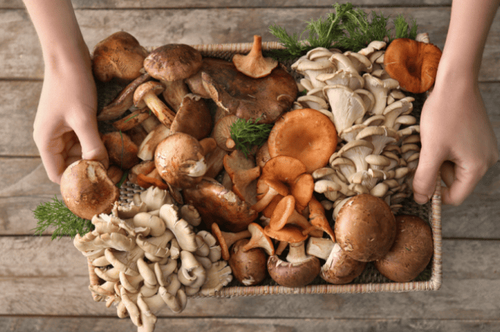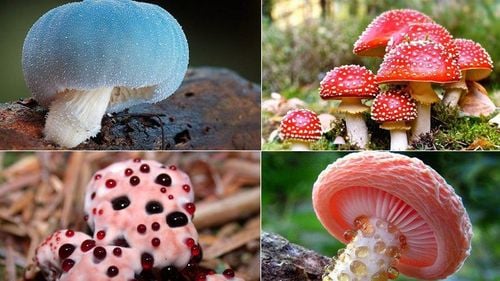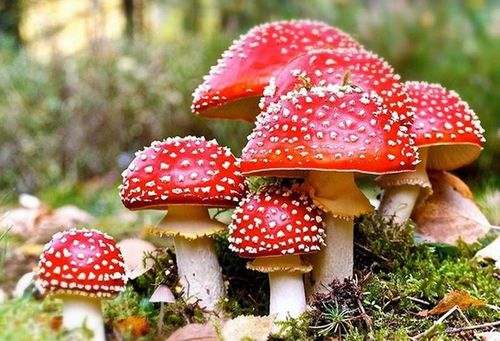This is an automatically translated article.
According to the Department of Food Safety - Ministry of Health, in fact, there are thousands of types of mushrooms, but there are about 70 - 80 types of poisonous mushrooms. Although the number of poisonous mushrooms is not much, it is difficult to distinguish between poisonous and non-toxic mushrooms. Therefore, people picking wild mushrooms and eating them are very susceptible to poisoning. The most deadly poisonous mushroom is usually the beautiful, eye-catching poisonous mushroom. The following article explains how to recognize poisonous mushrooms.1. Signs to recognize poisonous mushrooms
Common types of poisonous mushrooms are usually complete: blade, cap, stalk, ring stalk and base coat. The inside of the poisonous mushroom stem is pale pink, the mushroom cap is red with white scales, the mycelium glows in the night. The toxic part is in the whole mushroom body (cap, plate, ring, stalk, base coat), the toxin changes with the seasons, the growth process of the fungus, the soil environment, the climate.2. How to recognize common poisonous mushrooms
2.1 White canopy mushroom (Amanita verna) White canopy mushroom usually grows in clusters or singly on the ground in the forest and some other places... Mushroom cap is white, surface is smooth, when young, the head is round. Egg-shaped, mushroom caps firmly attached to stalks. When mature, the mushroom cap is flat with a diameter of about 5-10 cm. When old, the edge of the hat can be lowered. Mushroom plate: White. Stem: White, with a membranous ring in the upper part close to the cap. The base of the peduncle is bulbous and has a calyx-shaped base. Mushroom flesh: Soft, white, mild aroma. Main toxins: highly toxic amanitins (amatoxins) 2.2 White cone mushroom (Amanita virosa) Looks almost like a white canopy mushroom Grows in clusters or singly on the ground in forests and some other places... Mushroom cap: White color, smooth surface, mushroom cap at young, round ovate head, cupped edge attached to stem. When mature, the mushroom cap is usually cupped into a cone with a diameter of about 4 - 10 cm. Mushroom plate: White. Stem: White, with a membranous ring in the upper part close to the cap. The base of the peduncle is bulbous and has a calyx-shaped base. Mushroom flesh: Soft, white, unpleasant smell. Main toxins: amanitins (amatoxins), highly toxic White and white cones have major toxins which are highly toxic Amanitins (Amatoxins) that act on cellular protoplasm, cause damage to cells, especially liver cells, causing acute liver failure.Symptoms of mushroom poisoning often appear late (from 6-24 hours) such as abdominal pain, vomiting, loose diarrhea, jaundice, hemorrhage, little urine, coma... The treatment should be carried out as soon as possible to reduce the risk of death.

Các loại nấm độc thường gặp có màu sắc bắt mắt
2.4. Chlorophyllum molybdites (Chlorophyllum molybdites) Grows in clusters or singly at the edges of buffalo stables, cow sheds, lawns, cornfields and some other places... Mushroom cap: When young, long hemispherical, pale yellow, with small pale brown or light gray scales. At maturity, mushroom caps are umbrella-shaped or flattened, white, cap diameter: 5 – 15 cm. On the surface of the mushroom cap, there are thin dirty brown scales, the scales gradually thicken towards the top of the cap. Mushroom plate (underside of mushroom cap): When young, it is white, when it is old, it has a light green or grayish green color, the older the mushroom, the clearer it is. Stem: White to brown or gray in color, with a ring in the upper part close to the cap. The peduncle is not bulbous and has no root capsule; 10-30 cm long. Mushroom flesh: White Low toxicity, mainly causing digestive disorders. This is a fungus that belongs to the group of toxins that irritate the gastrointestinal tract - intestines. The rapidly acting poison causes nausea, vomiting, abdominal pain, cramps and diarrhea. Symptoms appear soon after eating from 20 minutes to 4 hours, and gradually decrease until 2-3 days.

Nấm mũ khía nâu xám là một trong các loại nấm độc thường gặp
If you have a need for consultation and examination at Vinmec Hospitals under the national health system, please book an appointment on the website (vinmec.com) for service.
Please dial HOTLINE for more information or register for an appointment HERE. Download MyVinmec app to make appointments faster and to manage your bookings easily.













